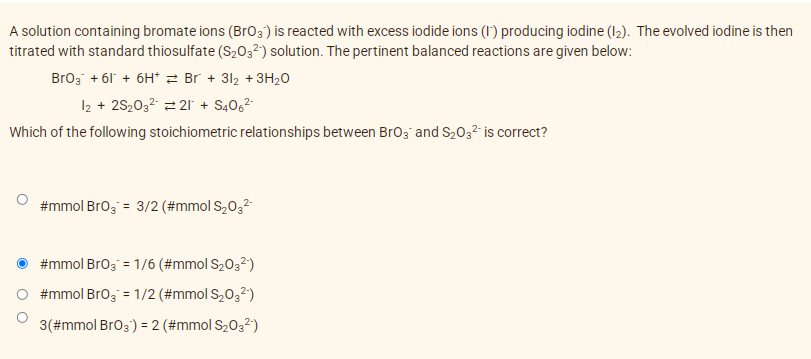ition containing bromate lons (Bro3 ) IS itrated with standard thiosulfate (S203²) solution. The pertinent balanced reactions are given below: excess lodide lons (1) producing lodine (12). evoived lodine is then Broz + 61 + 6H* 2 Br + 312 +3H20 2 + 2S,032 2 21 + S40,2 Nhich of the following stoichiometric relationships between BrOg and S203² is correct? #mmol Bro, = 3/2 (#mmol S,0,² #mmol Brog = 1/6 (#mmol S2032) O #mmol Bro3" = 1/2 (#mmol S,0,2) 3(#mmol BrO3) = 2 (#mmol S2032)
ition containing bromate lons (Bro3 ) IS itrated with standard thiosulfate (S203²) solution. The pertinent balanced reactions are given below: excess lodide lons (1) producing lodine (12). evoived lodine is then Broz + 61 + 6H* 2 Br + 312 +3H20 2 + 2S,032 2 21 + S40,2 Nhich of the following stoichiometric relationships between BrOg and S203² is correct? #mmol Bro, = 3/2 (#mmol S,0,² #mmol Brog = 1/6 (#mmol S2032) O #mmol Bro3" = 1/2 (#mmol S,0,2) 3(#mmol BrO3) = 2 (#mmol S2032)
Chemistry & Chemical Reactivity
9th Edition
ISBN:9781133949640
Author:John C. Kotz, Paul M. Treichel, John Townsend, David Treichel
Publisher:John C. Kotz, Paul M. Treichel, John Townsend, David Treichel
Chapter4: Stoichiometry: Quantitative Information About Chemical Reactions
Section: Chapter Questions
Problem 104GQ
Related questions
Question

Transcribed Image Text:A solution containing bromate ions (Br03) is reacted with excess iodide ions (1) producing iodine (I2). The evolved iodine is then
titrated with standard thiosulfate (S203²) solution. The pertinent balanced reactions are given below:
Broz + 61 + 6H* 2 Br + 312 + 3H20
12 + 2S203? 2 21 + S4062
Which of the following stoichiometric relationships between Brog and S2032 is correct?
#mmol Bro3 = 3/2 (#mmol S,032
#mmol Bro3 = 1/6 (#mmol S2032)
#mmol Bro3 = 1/2 (#mmol S,0,2)
3(#mmol Br03) =2 (#mmol S2032)
Expert Solution
This question has been solved!
Explore an expertly crafted, step-by-step solution for a thorough understanding of key concepts.
This is a popular solution!
Trending now
This is a popular solution!
Step by step
Solved in 2 steps with 2 images

Knowledge Booster
Learn more about
Need a deep-dive on the concept behind this application? Look no further. Learn more about this topic, chemistry and related others by exploring similar questions and additional content below.Recommended textbooks for you

Chemistry & Chemical Reactivity
Chemistry
ISBN:
9781133949640
Author:
John C. Kotz, Paul M. Treichel, John Townsend, David Treichel
Publisher:
Cengage Learning

Chemistry & Chemical Reactivity
Chemistry
ISBN:
9781337399074
Author:
John C. Kotz, Paul M. Treichel, John Townsend, David Treichel
Publisher:
Cengage Learning

Chemistry: Principles and Reactions
Chemistry
ISBN:
9781305079373
Author:
William L. Masterton, Cecile N. Hurley
Publisher:
Cengage Learning

Chemistry & Chemical Reactivity
Chemistry
ISBN:
9781133949640
Author:
John C. Kotz, Paul M. Treichel, John Townsend, David Treichel
Publisher:
Cengage Learning

Chemistry & Chemical Reactivity
Chemistry
ISBN:
9781337399074
Author:
John C. Kotz, Paul M. Treichel, John Townsend, David Treichel
Publisher:
Cengage Learning

Chemistry: Principles and Reactions
Chemistry
ISBN:
9781305079373
Author:
William L. Masterton, Cecile N. Hurley
Publisher:
Cengage Learning

Chemistry: The Molecular Science
Chemistry
ISBN:
9781285199047
Author:
John W. Moore, Conrad L. Stanitski
Publisher:
Cengage Learning

Chemistry for Engineering Students
Chemistry
ISBN:
9781337398909
Author:
Lawrence S. Brown, Tom Holme
Publisher:
Cengage Learning

Introductory Chemistry: A Foundation
Chemistry
ISBN:
9781285199030
Author:
Steven S. Zumdahl, Donald J. DeCoste
Publisher:
Cengage Learning